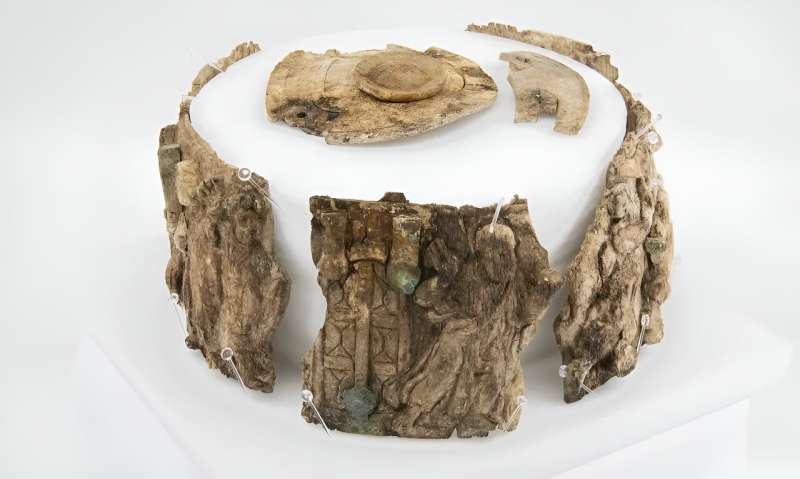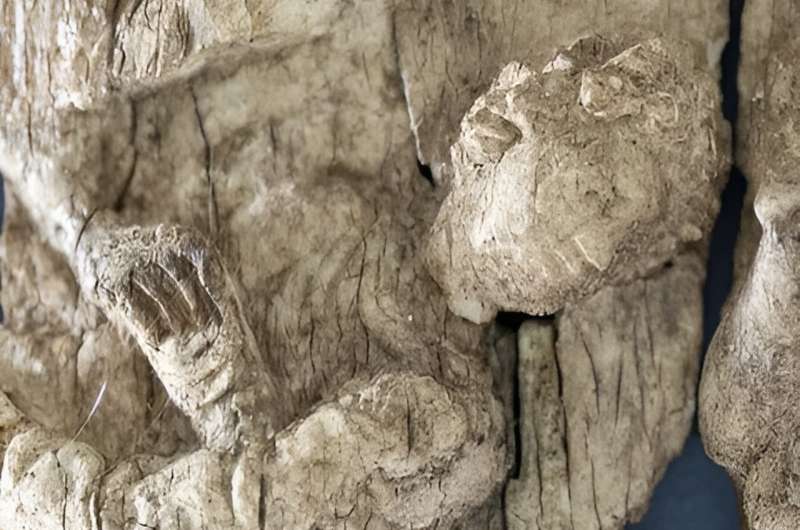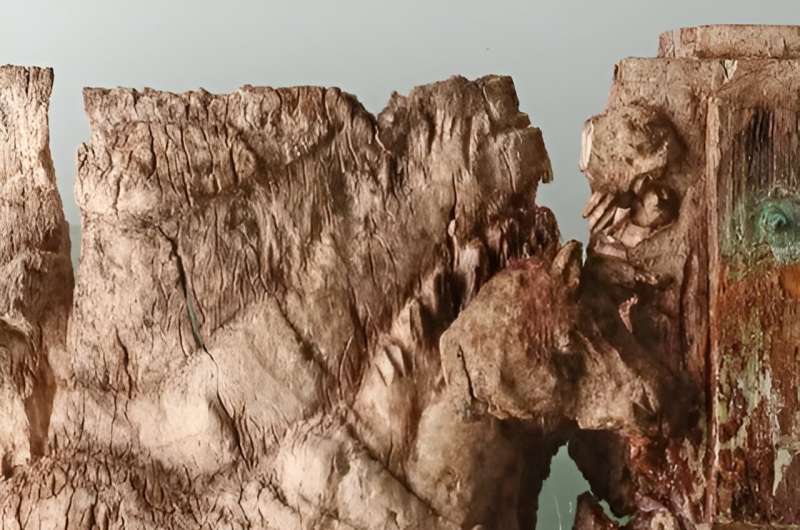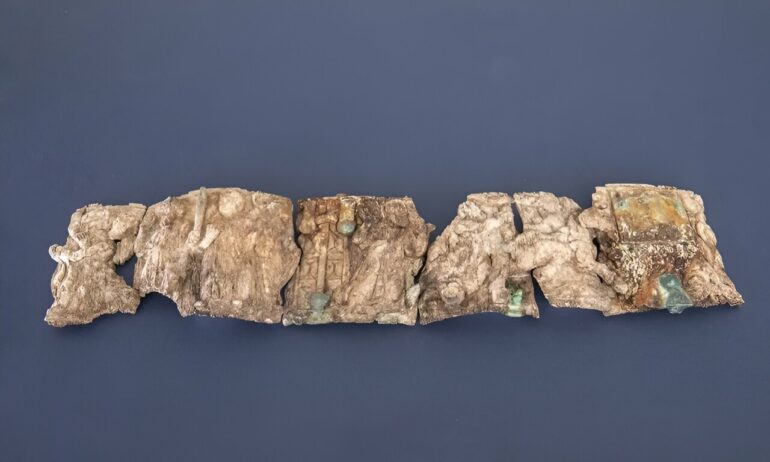Since the summer of 2016, archaeologists from Innsbruck have been carrying out excavations in a late antique hilltop settlement in southern Austria. Two years ago, they made a sensational discovery: a Christian reliquary was still hidden in a previously unknown church. It contained a richly decorated ancient reliquary box made of ivory.
On 4 August 2022, a team of researchers led by archaeologist Gerald Grabherr made the spectacular discovery in an early Christian church on the Burgbichl in the municipality of Irschen in southern Austria: A marble shrine measuring around 20 by 30 centimeters was hidden under the altar in the side chapel area.
The shrine contained a heavily fragmented ivory “box” (pyx) richly decorated with Christian motifs—a reliquary that is normally taken away as the “holiest” part when a church is abandoned. In this case, however, it was left behind. It is the first such pyx to be found in an archaeological context in Austria.
“We know of around 40 ivory boxes of this kind worldwide and, as far as I know, the last time one of these was found during excavations was around 100 years ago—the few pyxes that exist are either preserved in cathedral treasures or exhibited in museums,” explains the finder, Gerald Grabherr.
Complex conservation
Since its discovery, the 1,500-year-old, very fragile ivory reliquary has been conserved at the University of Innsbruck. “Ivory, especially ivory stored on the ground like in the marble shrine, absorbs moisture from its surroundings and is very soft and easily damaged in this state. In addition, uncontrolled drying out can lead to shrinkage and cracks and thus to damage that can no longer be repaired,” says Ulrike Töchterle, head of the restoration workshop in Innsbruck.
Over the past two years, she has now conserved the individual pieces of the ivory pyx to such an extent that they can be scientifically analyzed.
“Due to the very high humidity of 90% in the marble shrine immediately after salvage, the risk of condensation and mold formation was very high, and the contents could not be allowed to dry out too quickly. This meant we had to ensure a very careful and prolonged drying process.”

Ivory fragments of the pyx arranged in the round on a white background. © University of Innsbruck
The larger parts are deformed, which is why the pyx can no longer be restored to its original state—however, the researchers are working on a 3D reconstruction.
While the archaeologists initially assumed that the remains of a saint—i.e., a relic in the classic sense of the word—were also found in the marble box, the layering of the fragments found in the shrine indicates that the ivory pyx was already broken in late antiquity and was buried in the altar.
“The pyx was presumably also seen as sacred and was treated as such because it was in contact with a relic. The archaeological and art-historical significance of the pyx cannot be denied,” emphasizes Grabherr.

Close-up: Moses receives the commandments from the hand of God. © University of Innsbruck
Depiction of saints
At one end, the pyx shows a figure at the foot of a mountain—the man depicted is turning his gaze away and a hand rising out of the sky above him, placing something between the person’s arms. “This is the typical depiction of the handing over of the laws to Moses on Mount Sinai, the beginning of the covenant between God and man from the Old Testament,” says Grabherr.
This is followed by depictions of biblical figures. At the end, you can see a man on a chariot with two horses harnessed to it—and here, too, a hand coming out of the clouds pulls this figure up into heaven.
“We assume that this is a depiction of the ascension of Christ, the fulfillment of the covenant with God. The depiction of scenes from the Old Testament and their connection with scenes from the New Testament is typical of late antiquity and thus fits in with our pyx; however, the depiction of the Ascension of Christ with a so-called biga, a two-horse chariot, is very special and previously unknown.”

Close-up: Ascension of Christ on a biga. © University of Innsbruck
Further analyses
A number of further investigations into the Irschen reliquary are currently underway. “On the one hand, we still need to determine the exact origin of the marble, and we also want to specify the origin of the ivory and the elephant using stable isotope analyses. Metallic components—the hinges of the pyx were made of metal—are also still being examined, as is the glue that was used for the ivory,” explains restorer Töchterle.
Last but not least, wooden parts were also found in the marble box, presumably parts of the pyx’s clasp—it cannot be completely ruled out, but it is unlikely that this could be a relic after all. “These pieces of wood are also being analyzed more closely; we are particularly interested in the type of wood and its origin, and the age is also of interest to us,” says Töchterle.
Context: Hilltop settlement in Irschen
Irschen is a municipality in the Carinthian Drava Valley in southern Austria, where archaeologists from the University of Innsbruck have been carrying out excavations since 2016. They are investigating a late antique hilltop settlement that has been abandoned since around the year 610 and had so far been completely forgotten, covering an area of around one hectare (≈ 4.47 acres).
So far, the researchers have found and documented several dwellings, two Christian churches and a cistern in addition to the personal belongings of the settlement’s former inhabitants; a star-shaped baptismal font and a reliquary were discovered in one of the churches.
Grabherr says, “Towards the end of the Roman Empire, times became more uncertain, especially in the peripheral provinces of the empire, including the area that is now Austria. For this reason, from around the 4th century, the inhabitants increasingly founded settlements on hilltops that were easier to defend and left the valley floor.”
The year 610 marks a turning point: In this year, the Battle of Aguntum takes place not far from the Irschen settlement, where a Slavic army meets Baiuvari armies and settlers. This battle, which the Slavs win, marks the end of the region’s affiliation with the ancient Mediterranean world and also with Christianity—the Slavic settlers bring their own world of gods with them. The settlement on the Burgbichl has been abandoned since this time at the latest.
Provided by
University of Innsbruck
Citation:
1,500-year-old reliquary discovered (2024, June 25)



